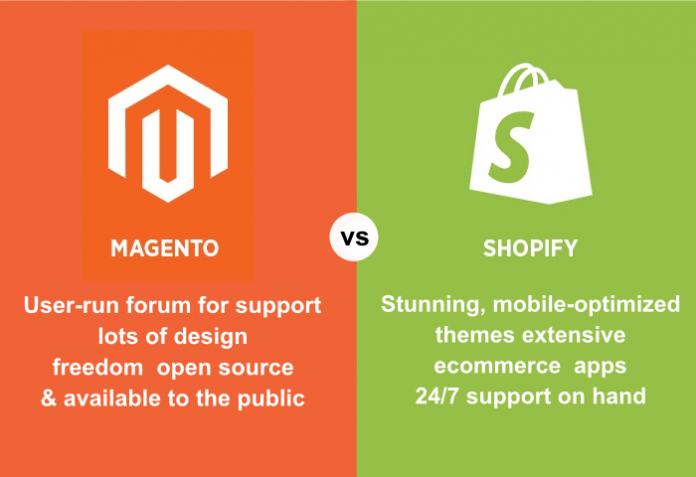Can’t decide between Shopify and Magento?
Most store owners are facing the same problem, so you are not alone. Today Magento and Shopify are the two most popular ecommerce platforms.
Magento:
Magento is an open-source eCommerce platform that provides online retailers with a scalable shopping cart framework as well as control over the appearance, content, and functionality of their online store. Magento’s marketing, SEO, and catalog-management tools are all extremely strong.
Shopify:
Shopify is an e-commerce website that enables everyone to open an online store and sell their goods. With Shopify POS, merchants can also sell their goods in person. Shopify is now the most popular e-commerce site for companies of all sizes. If you sell online, on social media, in a store, or out of the trunk of your car, Shopify has you covered. Our first Shopify store was our own, and we’ve made it our goal to improve commerce for everyone since then.
Are you eager to know what is Magento 2?
Magento 2 is the most recent version of the world’s most popular enterprise-class eCommerce platform, which is used by over 200,000 online merchants. In reality, Magento is estimated to be used by one out of every four companies. It’s easy to see why: M2 has a wide variety of versatile resources that can handle any and all of your specialized marketing, SEO, and catalog-management needs – now more than ever. It’s safe to assume that managing the appearance, content, and functionality of your online company is now simpler than ever.
1. Magento vs Shopify: Pros and Cons
Shopify:
Pros:
- There are a plethora of lovely sensitive store themes to choose from.
- An all-in-one eCommerce platform
- Excellent app store for enhancing the website’s features.
- Customer service is very strong.
- Simple to use
- There are several checkout and payment options available.
- A large number of devoted fans
Cons:
- The majority of themes have a cost associated with them.
- It becomes more difficult to integrate applications into your shop.
- Any transaction is subject to a fee (unless you use Shopify payments)
Magento:
Pros:
- Excellent user group with a lot of support.
- Platform with a lot of customizability choices
- There is a good range of themes to choose from.
- There is phone help online.
- Magento commerce does not necessitate any coding expertise.
- Magento is an open-source project that is completely free to use.
- Extensions for Magento 2
Cons:
- There is a slight learning curve.
- For beginners, it’s very challenging.
- It takes a long time to set up.
- There are several costs associated with opening a shop.
2. Ease Of Use
If you choose a platform that is too difficult to use, you will be unable to build the e-commerce store you want, which may be detrimental to your brand’s reputation.
Shopify is much more user-friendly than Magento. It’s a proven fact. Shopify is a drag-and-drop website builder that allows you to easily customize your store by dragging and dropping elements across the list. Shopify received a 4.1/5 in our ease of use report, while Magento received a 2.5. In essence, Shopify is designed for users at all technical skill levels, while Magento is designed exclusively for web developers. In comparison to Shopify, the learning curve for Magento is very steep. To create the online store you want, you’ll need to translate jargon and use code or employ a web developer to do it for you.
If you are someone that is looking to migrate magento to shopify plus and are unsure about your decision, you should definitely proceed. Everything from the way the customizations work to the easy interface that can be handled with anyone with a little knowledge, Shopify Plus is redefining the way businesses should use an ecommerce platform. The convenience of not following a code structure and enabling easy integrations with everything from payment gateways to logistics partners is what makes Shopify Plus a much better option than Magento.
Magento vs Shopify – Ease of use:
Magento is more difficult to use than Shopify. Magento is more versatile than Shopify in that it allows you to customize your store with code, but it’s still much more difficult to use – making it difficult for most users to create a store they’re proud of.
3. Themes and Design
While there is much more to your website than how it looks, a visually pleasing site is much more appealing and easier to navigate. Having the right theme will help you have a great user experience while also allowing you to stand out from the crowd.
Shopify has a lot of amazing and completely customizable themes to choose from in terms of frontend appearance. Furthermore, Shopify’s themes are simple to use. You’re essentially good to go as long as you can add your own content and goods.
Another advantage of Shopify from a design standpoint is that its themes are mobile-friendly. This means they’ll impress Google and your clients regardless of whether they’re using a laptop or not. This might result in you spending a little too much money on your website. On the plus hand, if you have the funds, Shopify provides a wealth of customization choices, including the ability to adjust your color palette, add new pages to your website, delete and resize components, and much more. You can also use social media resources to enhance your website.
Magento, on the other hand, has a much smaller selection of themes. There are a total of 16 themes available, with free and paid versions available. Ten of the themes are mobile sensitive, meaning they will automatically resize to fit any screen. Magento also helps you to customize your own theme and make changes to your website’s design from the backend. This, on the other hand, necessitates much more developer expertise than Shopify or even Shopify Plus.
Magento vs Shopify – Themes:
Shopify has a larger (and less expensive) theme selection than Magento. You don’t need to know how to code to customize Shopify’s themes, which makes customizing your chosen template to your brand’s needs a breeze.
4. SEO
SEO aids in the amount of search engine traffic to your website, resulting in more paying clients and more money in the bank.
Magento excels at SEO and has a plethora of SEO guides and prompts to get you started. You can change image alt tags (which Google uses to figure out how to categorize an image on the image search platform) and URLs to make it easier for search engine users to locate your web pages. Many of these features are also built-in.
Shopify, on the other hand, is more focused on smartphones for SEO. Although you can change page titles and image alt tags, the majority of your SEO tricks will have to be found in the app store.
Magento vs Shopify – SEO:
In terms of SEO, Magento takes the lead over Shopify. It comes with a broader set of SEO tools, including SEO prompts and the ability to customize URLs. Many of your SEO wants and needs will require you to check for and install apps with Shopify.
5. Sales Tools
Ecommerce platforms and sales tools are inextricably linked. Isn’t it true that you can’t have one without the other? Let’s take a look at what’s under the hood of Shopify and Magento.
In our research on sales functionality, Shopify earned a 4.7/5 rating. The following are some of Shopify’s best features for selling goods and making money:
Recovery of abandoned carts – recover potentially missed revenue by sending automated emails to customers who left your website without completing an order.
Multi-channel sale is a built-in feature that allows you to sell on Amazon, Facebook, Pinterest, and Instagram.
Offer digital items for sale (as well as physical ones)
In the same category, Magento earned a 4/5 rating. Magento’s inventory system has a lot of great features built-in, including bulk product import from your database, various product variants, overall sales reports, and total visitor count.
Magento vs Shopify – Sales Tools:
Shopify offers a larger selection of sales resources than Magento. Shopify is one of the best e-commerce sites available, with several built-in features such as multichannel sale, which is only available via Magento’s expensive extensions.
6. Marketing Features
Having access to effective marketing resources can assist the company in attracting new customers and increasing profits. What’s not to like about that?
Shopify has excellent marketing tools, including the ability to send email campaigns through third-party integrations with Segundo, Klaviyo, Constant Contact, and other companies. You may also use Facebook, Instagram, and Pinterest to promote and sell directly. We really like Shopify’s multilingual support, which allows you to sell items in multiple languages.
Magento, on the other hand, relies heavily on its Marketplace for the majority of its marketing resources. To run email campaigns, for example, you’ll need to install extensions like Remarkety.
Magento vs Shopify – Marketing Tools:
Shopify just wins this one. Both Magento and Shopify rely on their respective app markets for the most important marketing features, such as the ability to create email campaigns, but Shopify enables you to advertise on social media as a built-in feature.
7. Price
The primary distinction is that Shopify is a hosted website, while Magento is self-hosted. Shopify, for example, is a hosted site that takes care of all your hosting concerns. All hosting expenses are included in your monthly schedule, so you don’t have to do anything extra. In the meantime, Magento is free to download and install, but you’ll have to pay for web hosting, encryption, extensions, and a domain name. Shopify offers three different pricing plans, each with a fixed monthly rate. The total cost of Magento, on the other hand, will be determined by a variety of factors. You must pay for your web hosting in order to use Magento (remember that SiteGround is one of the few providers that supports Magento).
Magento vs Shopify – Pricing:
It’s a deadlock. Since Magento and Shopify are two very different platforms, they have different pricing models. Magento is an open-source platform, so the pricing can vary depending on your needs, while Shopify has three fixed price options that may seem to be less expensive at first glance, but you’ll still have to pay for applications and themes.
Magento eCommerce Review:
Magento is a user-friendly solution for those who do not have the technological skills to code a custom solution from scratch. Magento is designed for scalability, so you can expect it to be simple to scale things up when the time comes. Since Magento has the potential to be such a large product, it can become very feature-rich. This is beneficial in the sense that you can make Magento do almost anything you want.
Shopify eCommerce Review:
Shopify is extremely user-friendly, particularly for those who have never run an eCommerce shop before. On the other hand, it provides all of the features that a business owner could need. Furthermore, you are not required to take a web development or coding course. More advanced users, on the other hand, gain access to the CSS and HTML files and can upgrade their Shopify plan as their store expands to get more robust features. Overall, it’s a well-designed eCommerce platform with a variety of themes that are both modern and trendy, as well as plain and minimalist if that’s what you like.
Takeaway:
Even if both Shopify and Magento are capable eCommerce sites, Shopify offers a more user-friendly experience since it is a hosted and controlled application.
Although Magento is free, it does require you to buy hosting and perform all software/system configuration and installation procedures yourself, which only moderately tech-savvy people (rather than traditional end-users) are capable of. In light of this, as well as some of the other points raised above, Shopify emerges as the clear winner as an eCommerce platform for creating an online store that is both simple to use and strong.



















Thank you for such a professional article. It has helped me to choose the right eCommerce platform.
Very Helpful!
Great article!
This is a really really amazing write-up. This is the best guide I have read which explains everything in a short, crisp, and interesting manner!
Hi tһere! Someone in my Facebook group shared this website with us so I came to look it over.
I’m defіnitely loving the informatiоn. I’m bookmɑrking and wkll be tweeting this to my followers!
Good post! We are linking to this particularly great article on our site.
Keep up the good writing.
The efficient ideas you supplied are actually visiting be actually very beneficial.
I’ll be actually executing them soon.